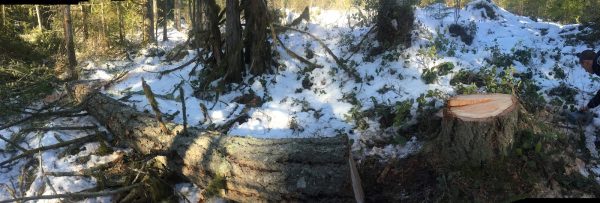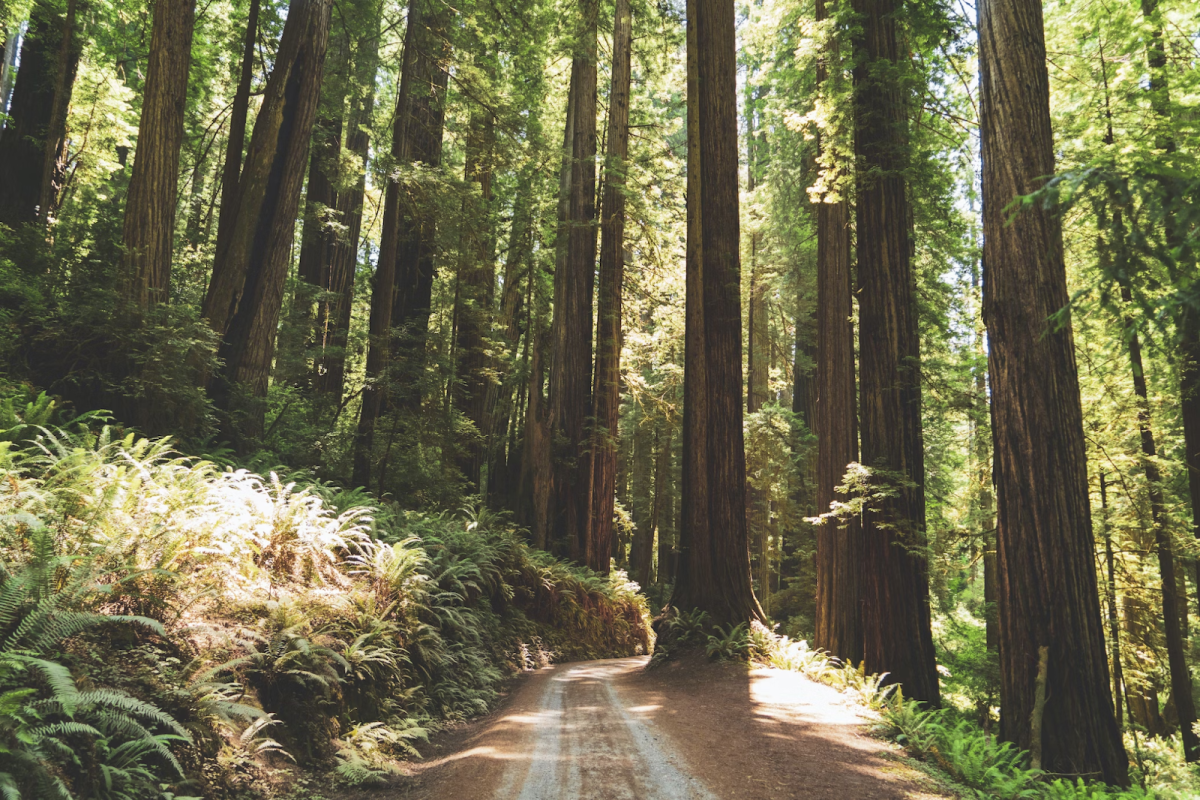Tree poaching is defined as destruction or theft of wood in violation of state, federal, or foreign law. It is one of the largest criminal sectors worldwide and costs an annual $1 billion in the U.S. alone.
Yet when writer, oral historian, and National Geographic Explorer Lyndsie Bourgon began researching illegal logging for her book Tree Thieves and shadowed rangers at various poaching sites, she felt surprised by its perceived normalcy.
Tree poaching sites can easily blend into the forest scenery to an untrained eye like Bourgon’s. As she hiked through the woods, her mind instinctively skipped over scars on tree trunks, fallen branches, or sawdust hinting towards a prior human presence. Even when noticed, these clues sometimes felt trivial. Perhaps the difficulty came from the fact that a poaching site is ultimately defined by the absence of what is there — the wood that was stolen, loaded into a truck, and driven away in the dead of night.
The theme of absence is interwoven throughout the narrative of tree poaching in the Pacific Northwest. Where was the respect that Indigenous peoples deserved during the period of westward expansion? Where was the empathy and support that logging towns needed during times of transition in the late twentieth century? And, if one out of ten trees currently logged on U.S. Forest Service land is done so illegally, where is all this wood now?
Causes and Motivations
North American trees are like European cathedrals. Both are towering, majestic capsules of culture and history; trees flaunt additional environmental value as well. However, a tree’s worth becomes trivialized when poachers illegally sell their wood to tourist shops, lumber mills, and even established companies like IKEA. North America’s natural heritage and key defense against global warming is dispersed into everyday homes as firewood, roof shingles, or cardboard boxes.
But the blame doesn’t lie solely on the poachers. In fact, the historical methods of preserving these trees have caused poachers to become both the perpetrators and the victims.
From a birds eye view, the pre-colonial Pacific Northwest would have appeared to be an enormous swath of green. Glide too far west and you’d abruptly encounter another solid block of color, the deep blue Pacific ocean. Drift too far east and you’d face the snow-capped peaks of the Rocky Mountains. Swoop closer to ground level and you’d find the hundreds of Indigenous tribes that had inhabited the land for millennia such as the Heiltsuk, Tillamook, and Yurok.
This was the setting of the original crime scene, where nineteenth-century white settlers stole land, trees, and natural resources originally belonging to Indigenous peoples. These settlers established logging towns that swelled in size and population. The old-growth (mature) redwood and douglas fir trees that had been respected in many Indigenous cultures were now viewed as an infinite and expendable resource, harvested and sold to feed the industrial logging economy.
Over the span of several decades, Americans erased a forest that had survived for millennia. By the 1960s, they had logged 90% of trees and severely diminished the redwoods’ original 2 million acre range. Environmentalists soon began scrambling to save the remaining trees. The government transferred ownership of 58,000 acres of land to the National Parks Service and created Redwood National Park in 1968, a haven protecting the west coast’s natural beauty.
Despite good intentions, not everyone supported the park’s creation. Previously, the Forest Service had managed that land and sold portions to logging firms; the profit was shared by both the company and the federal government. To loggers, the new prospect of their land becoming completely off-limits was daunting. Entire communities centered around logging experienced huge plunges in revenue and employment. Many people felt separated from their family history and heritage of logging, adding an additional, intangible loss.
Members of Congress visited some of these towns and recorded the residents’ complaints and opinions. But those feelings remained trapped in ink on paper, never bringing an adequate form of compensation or recognition to the problems that people faced. The promise that National Park-induced tourism would make up for their economic loss did not come to fruition.
Bourgon referred to this neglect as ‘exclusive conservation.’ “There was a real missed opportunity that we’re still seeing the trickle-down effects of now,” she observed. When Bourgon interviewed present day residents of towns such as Orick, a logging town in Northern California, she noticed a pattern of expressing grief for lost work, purpose, community, and family history. These all contribute to underlying motivations of tree poaching. “They commit crime as an expression of that sadness,” Bourgon noted.
The government expanded the Redwood National and State Park to encompass 106,000 acres in 1978, then extended the boundaries even further in 2009. By that time, the amount of logged old-growth redwoods had risen to 96%. The government initiative to protect redwoods was timely and admirable; however, it failed to support loggers during this transition and indirectly plunged logging towns deeper into poverty, unemployment, and drug addiction. Illegally harvesting timber within park boundaries and selling it for fast cash became a means of survival for some. The government’s actions to conserve old-growth had ironically laid the foundation for future poaching.
“This is a topic that affects everybody,” said Bourgon. “How do we feel empathy when it comes to these big policy changes that have to happen? How can we do it better, and how can we acknowledge that maybe we didn’t do it right the first time?”
Responses and Management
Tree poaching rarely means cutting down an entire tree; redwoods can grow taller than 300 feet and from 25 to 40 feet in diameter. Instead, poachers saw off burls, large bulbous protrusions from the trunk of a tree that can weigh hundreds of pounds and sell for thousands of dollars.
Burls are a redwood’s primary method of reproduction. They safely store a tree’s DNA and strengthen the tree’s defense against insects and disease. They also happen to have particularly beautiful wood inside. Burls have the dangerous double identity of being both environmentally and materialistically valuable.

Once someone encounters a burl poaching site, punishing the poacher depends on the available evidence. If they are able to identify the tree, the stump, and the people involved, then they could prosecute the poachers. Across the Pacific Northwest, results of these investigations vary depending on the situation and who the wood was stolen from. Some fines are considerably less than the wood was sold for; some are huge, unrealistic fees meant to symbolize a tree’s worth. Fines can discourage poachers, but they don’t address the root motivations of poaching.
In Redwood National and State Park, the methods for poaching prevention often mirror criminal investigations — using hidden cameras in the forest, for example, or patrolling the area as much as resources and funding allows.
“We interview suspects, conduct surveillance, apply for search warrants, and process evidence at poaching crime scenes,” said Chief Ranger Steve Troy, head of the Redwood National Park Law Enforcement Division. “We’ve seen an impact from our efforts and think they have been pretty successful.”
These measures are necessary and significant steps towards protecting redwoods. But timber poaching on a global scale is inherently tricky to monitor, especially in the context of trade. Permits can be forged, and shipments can conceal poached lumber within a cargo that is mostly legal. To uncover illegal wood in a global market, officials would need to trace a product all the way back to the stumps in the forest that it came from, an arduous and often unworthwhile process.
The pressure and time restraints of customs officials, the little incentive for companies to meticulously track their supply chain, and the general public’s lack of awareness all contribute to lots of wood and little questioning. “Our globalized systems are so convoluted that it makes it very easy for illegal wood to be folded into the legal market,” said Bourgon.
Importance and Relevance
This international trade is partially monitored by Interpol, who estimates that the illegal timber industry is worth up to an annual $152 billion worldwide. But how can you equate trees with a fixed number of dollars? Like the rings that encircle an exposed stump, there are countless layers that contribute to a tree’s value beyond the board foot market price.
Old-growth tree poaching isn’t just a problem in North America; combined across the continents, it has a large environmental impact. Old-growth forests are carbon sinks, meaning they reduce global warming by storing a substantial amount of carbon from the Earth’s atmosphere. Young trees, in contrast, do not have capacity to store as much.
Old-growth also provides invaluable habitats for animals such as the spotted owl, which cannot live in younger trees. The deforestation of old-growth brought this species to near extinction in the 1980s (sparking what was known as the timber wars). While planting new trees to counteract this environmental loss is progress, it is not a quick fix. It will be hundreds of years before new trees mature into the status of old-growth.
Alongside this, these trees have accumulated cultural connections to those who live around them. First and foremost, these trees hold an importance to Indigenous societies. They are also central to family logging legacies and the idea of preserving North America’s natural heritage. All these perspectives carry cultural weight rooted in the forest.
Lastly, the irreplaceable beauty and recreational significance of old-growth is immeasurable. The Redwood National and State Park is a UNESCO World Heritage Site, meaning it has universal value. No matter the person, it is both humbling and empowering to stand among towering trees that bridge the earth and sky. “There is a reason why we’ve tried to preserve that remaining four percent, and it’s undeniable,” reflected Bourgon.
“Now that they are protected, they won’t just be a memory but can be a reality for people,” added Troy.
Without a solid understanding of the nuanced value infused in old-growth trees, the gap left in their absence may appear small or inconsequential. Learning and educating others about the ignored voices in history, the disappearing species dependent on old-growth, and the dwindling impact of carbon sinks is important — these are all related absences that contribute to the larger, undeniable hole that poaching creates.
However, although this is a narrative of absences, the outcome depends on who is present in the dispute. From the poacher to the everyday person whose purchase could unknowingly fuel the illegal timber market, everyone holds varying degrees of responsibility regarding tree poaching.
These nuanced causes, effects, and perspectives involved in tree poaching was part of what led Bourgon to research it so deeply. Each old-growth forest she visited across the Americas was intertwined with the lives of many different people, both modern and historical. Yet they were also strikingly familiar – the same tall trunks, rough bark, and soft dirt characterizing each trail.
Bourgon turned a bend, leaves crunching beneath her feet and confining the sky above. It was a beautiful day for hiking. That is, until the ranger she was traveling with noticed a nearby poaching site.
“If that hadn’t been pointed out to me, if I didn’t know what was here before, I would just have kept walking by and not known what was missing.”
“How do we feel empathy when it comes to these big policy changes that have to happen? How can we do it better, and how can we acknowledge that maybe we didn’t do it right the first time?” said writer, oral historian, and National Geographic Explorer Lyndsie Bourgon.

